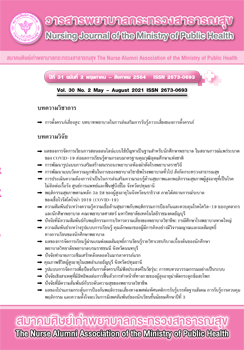The Development of Nursing Care Model for Elderly with Hip Fracture in Fast-Track Surgery, Phrae Hospital
Main Article Content
Abstract
A comparative study of health literacy on prevention of premature pregnancy between tribal and lowland high school students was conducted by a mixed-methods study using both quantitative and qualitative data collection methods. For the quantitative data, a questionnaire regarding health literacy on prevention of premature pregnancy was used to ask 216 high school students including the groups of tribal and lowland high school students. Each group comprised 108 students. For the qualitative data, in-depth interviews were conducted with 16 individuals. Descriptive statistics were used to analyze the quantitative data while content analysis was used to analyze the qualitative data, using the conceptual framework of the research to identify the main themes. The findings revealed that the average age of the sample was 17 years. In line with the objective of the study, it was found that the level of health literacy on prevention of premature pregnancy among the tribal and lowland students was at moderate level. The mean score was 113.15 and standard deviation was 16.00. The mean scores of access to health information and services, teaching health literacy, managing own health status and media and information literacy on prevention of premature pregnancy were moderate. Cognitive aspect of health was at a low level while decision making for correct practice was at a very good level. The total means scores of health literacy on prevention of premature pregnancy of the tribes and lowland high school students in were 107.03 (SD = 14.04) and 119.27 (SD = 15.54). Independent t-test statistics showed that there were statistically differences in the mean scores of almost all aspects at the significant level of .05 except element 6 “decision making for correct practice to prevent premature pregnancy”.
Article Details
บทความและรายงานวิจัยในวารสารพยาบาลกระทรวงสาธารณสุข เป็นความคิดเห็นของ ผู้เขียน มิใช่ของคณะผู้จัดทำ และมิใช่ความรับผิดชอบของสมาคมศิษย์เก่าพยาบาลกระทรวงสาธารณสุข ซึ่งสามารถนำไปอ้างอิงได้
References
2. Rojanasthien S, Luevitoonvechkij S. Epidemiology of hip fracture in Chiang Mai. J Med Assoc Thai 2005; 88(5):105-09.(in Thai).
3. Kanis JA, Oden A, McCloskey EV, Johansson H, Wahl DA, Cooper C. IOF working group on epidemiology and quality of life. a systematic review of hip fracture incidence and probability of fracture worldwide. Osteoporosis International 2012;23(9):2239–56.
4. Khanthanon A. Nursing care of elderly’s fracture neck of femur with chronic disease: case study. Region 11 Medical Journal 2013;7(2):271-80.(in Thai).
5. Liuponwanich P, Pakpienpairot C, Leechawengwong S. An integration approach in prevention and treating refractures from osteoporosis. Journal of the Department of Medical Services 2015;40(4):16-9.(in Thai).
6. Phrae Hospital : Medical records & statistic. Phrae, Phrae Hospital;2021.(in Thai).
7. Dehbozorgi A, Khan M, Rahmani MJH. Delayed hospital discharges; could pressure sore incidents in fractured neck of femurs patients and elevated nutritional needs be a contributing factor?. Global Journal of Medical Research 2016;16(4):1-4.
8. Poh KS, Lingaraj K. Complications and their risk factors following hip fracture surgery. J Orthop Surg (Hong Kong) 2013;21(2):154–57.
9. Mamom J. Nursing care of orthopedic patients. Bangkok: Thammasat University Press;2019.(in Thai)
10. Patient Care Team of Phrae Hospital. Annual work report,2020.(in Thai).
11. National Health and Medical Research Council. How to put the evidence into practice:Implementation and dissemination strategies [internet].2000 [cited 2021 July 12]. Available: http://www.nhmrc.gov.au/PUBLICATIONS/synopses/_files/cp71.pdf.html
12. American Society of Anesthesiologists. ASA physical status classification system [internet].2014 [cited 2021 July 12]. Available: https://www.asahq.org/standards-and-guidelines/asa-physical-status-classification-system.
13. Roobsoong A, Permyao J, Chantiratikul S. Clinical outcomes of peritrochanteric hip fracture in the intermediate postoperative care project between the regional and district hospitals in Chiang Rai Province: preliminary comparative results. Journal of Health Systems Research 2020;14(1):88-100.(in Thai).
14. Kawpradit A. Development of urgent surgery system for fractures around the hip in Rayong Hospital. Rayong Hospital Medical Journal 2020;19(36):33-9.
15. Flikweert ER, Izaks GJ, Knobben BA, Stevens M, Wendt K. The development of a comprehensive multidisciplinary care pathway for patients with a hip fracture: design and results of a clinical trial. BMC Musculoskeletal Disorders 2014;15:188.

